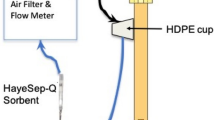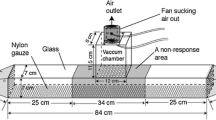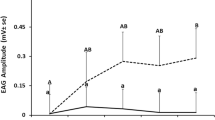Abstract
Olfaction is a key sensory modality for many arthropods and could be used as a tool in pest management through manipulation of pest behavior. Management of Varroa destructor, important parasitic mites of honey bees, could be improved through better understanding of the chemical ecology of this host-parasite relationship. We refined techniques of mounting mites to obtain electrophysiological recordings (electrotarsograms) of their responses to synthetic odor stimuli. Results of 271 electrotarsogram recordings from V. destructor revealed responses to 10 odorants relative to solvent controls. Electrotarsogram responses to methyl palmitate, ethyl palmitate, and 2-heptanol were highest at the lowest stimulus loading (10 ng) we tested, suggesting that V. destructor may have acute sensitivity to low concentrations of some odors. Results suggest that odorant origin (e.g., methyl oleate from honey bee larvae, geraniol from adult honey bee alarm pheromone, and α-terpineol, a plant secondary metabolite) can influence the degree of electrophysiological response. Varroa destructor tended to be more responsive to known attractants and repellents relative to previously unexplored odorants and some repellent terpenes. Electrotarsograms offer the potential for screening odors to determine their importance in V. destructor host detection.





Similar content being viewed by others

Explore related subjects
Discover the latest articles and news from researchers in related subjects, suggested using machine learning.References
Bissinger BW, Roe RM (2010) Tick repellents: past, present, and future. Pestic Biochem Physiol 96:63–79
Blum MS (1996) Semiochemical parsimony in the Arthropoda. Annu Rev Entomol 41:353–374
Boot WJ (1994) Methyl palmitate does not elicit invasion of honeybee brood cells by Varroa mites. Exp Appl Acarol 18:587–592
Boot WJ, Beetsma J, Calis JNM (1994) Behaviour of Varroa mites invading honey bee brood cells. Exp Appl Acarol 18:371–379
Breed MD, Guzmán-Novoa E, Hunt GJ (2004) Defensive behaviour of honey bees: organization, genetics, and comparisons with other bees. Annu Rev Entomol 49:271–298
Calderone NW (1999) Evaluation of formic acid and thymol-based blend of natural products for the fall control of Varroa jacobsoni (Acari: Varroidae) in colonies of Apis mellifera (Hymenoptera: Apidae). J Econ Entomol 92:253–260
Calderone NW, Lin S (2001) Behavioural responses of Varroa destructor (Acari: Varroidae) to extracts of larvae, cocoons and brood food of worker and drone honey bees, Apis mellifera (Hymenoptera: Apidae). Physiol Entomol 26:341–350
Carr AL, Roe M (2016) Acarine attractants: chemoreception, bioassay, chemistry and control. Pestic Biochem Physiol 131:60–79
Carr AL, Roe RM, Arellano C, Sonenshine DE, Schal C, Apperson CS (2013) Responses of Amblyomma americanum and Dermacentor variabilis to odorants that attract haematophagous insects. Med Vet Entomol 27:86–95
Carroll MJ, Duehl AJ (2012) Collection of volatiles from honeybee larvae and adults enclosed on brood frames. Apidologie 43:715–730
Currie RW, Pernal SF, Guzmán-Novoa E (2010) Honey bee colony losses in Canada. J Apic Res 49:104–106
Del Piccolo F, Nazzi F, Vedova G, Della Milani N, Del Piccolo F, Nazzi F, Vedova G, Della Milani N, Del Piccolo F, Nazzi F, Vedova G, Della Milani N (2010) Selection of Apis mellifera workers by the parasitic mite Varroa destructor using host cuticular hydrocarbons. Parasitology 137:967–973
Dietemann V, Nazzi F, Martin SJ, Anderson DL, Locke B, Delaplane KS, Wauquiez Q, Tannahill C, Frey E, Ziegelmann B, Rosenkranz P, Ellis JD (2013) Standard methods for Varroa research. J Apic Res 52:1–54
Dillier F, Guerin P, Fluri P, Imdorf A, Meyre PB, Diehl P, Bee S (2003) Odour-mediated transfer to brood cells of its honeybee host, Apis mellifera, and olfactory cell responses of Varroa destructor to volatiles. Swiss Bee Res Cent 1–14
Dillier F-X, Fluri P, Imdorf A (2006) Review of the orientation behaviour in the bee parasitic mite Varroa destructor: sensory equipment and cell invasion behaviour. Rev Suisse Zool 113:857–877
Donzé G, Schnyder-Candrian S, Bogdanov S, Diehl P-A, Guerin PM, Kilchenman V, Monachon F (1998) Aliphatic alcohols and aldehydes of the honey bee cocoon induce arrestment behavior in Varroa jacobsoni (Acari: Mesostigmata), an ectoparasite of Apis mellifera. Arch Insect Biochem 37:129–145
Eliash N, Singh NK, Kamer Y, Pinnelli GR, Plettner E, Soroker V (2014) Can we disrupt the sensing of honey bees by the bee parasite Varroa destructor. PLoS ONE 9:1–13
Endris J, Baker R (1993) Action potentials recorded from the foreleg of Varroa jacobsoni after olfactory stimulation. Apidologie 24:488–489
Ferland J, Nasr M, Wilson G, Jordan C, Kempers M, Kozak P, Lafreniere R, Maund C, Pernal S, Sproule J, Van Westendorp P (2017) Canadian Association of Professional Apiculturists (CAPA): statement on honey bee wintering losses in Canada (Quebec)
Foster SP, Harris MO (1997) Behavioral manipulation methods for insect pest management. Annu Rev Entomol 42:123–146
Frey E, Rosenkranz P (2014) Autumn invasion rates of Varroa destructor (Mesostigmata: Varroidae) into honey bee (Hymenoptera: Apidae) colonies and the resulting increase in mite populations. J Econ Entomol 107:508–515
Frey E, Odemer R, Blum T, Rosenkranz P (2013) Activation and interruption of the reproduction of Varroa destructor is triggered by host signals (Apis mellifera). J Invertebr Pathol 113:56–62
Ganske A-S, Uhl G (2018) The sensory equipment of a spider: a morphological survey of different types of sensillum in both sexes of Argiope bruennichi (Araneae, Araneidae). Arthropod Struct Dev 47:144–161
Gelman A, Hill J (2007) Data analysis using regression and multilevel/hierarchical models. Cambridge University Press, New York
Gilley DC, DeGrandi-Hoffman G, Hooper JE (2006) Volatile compounds emitted by live European honey bee (Apis mellifera L.) queens. J Insect Physiol 52:520–527
Gray A, Brodschneider R, Adjlane N, Ballis A, Brusbardis V, Charrière JD, Chlebo R, Coffey F, Cornelissen M, Amaro da Costa B, Csáki C, Dahle T, Danihlík B, Dražić J, Evans MM, Fedoriak G, Forsythe M, de Graaf I, Gregorc D, Johannesen A, Kauko J, Kristiansen L, Martikkala P, Martín-Hernández M, Medina-Flores R, Mutinelli CA, Patalano F, Petrov S, Raudmets P, Ryzhikov A, Simon-Delso VA, Stevanovic N, Topolska J, Uzunov G, Vejsnaes A, Williams F, Zammit-Mangion A, Soroker V (2019) Loss rates of honey bee colonies during winter 2017/18 in 36 countries participating in the COLOSS survey, including effects of forage sources. J Apic Res 58:479–485
Grozinger CM, Fischer P, Hampton JE (2007) Uncoupling primer and releaser responses to pheromone in honey bees. Naturwissenschaften 94:375–379
Hanes MR (2015) Response of olfactory neurons in Varroa destructor mites to attractant and repellent semiochemicals. Acadia University, Wolfville
Hoppe H, Ritter W (1988) The Influence of the Nasonov pheromone on the recognition of house bees and foragers by Varroa jacobsoni. Apidologie 19:165–172
Human H, Brodschneider R, Dietemann V, Dively G, Ellis JD, Forsgren E, Fries I, Hatjina F, Hu F-L, Jaffé R, Jensen AB, Köhler A, Magyar JP, Özkýrým A, Pirk CWW, Rose R, Strauss U, Tanner G, Tarpy DR, van der Steen JJM, Vaudo A, Vejsnæs F, Wilde J, Williams GR, Zheng H-Q (2013) Miscellaneous standard methods for Apis mellifera research. J Apic Res 52:1–53
Imdorf A, Bogdanov S, Ochoa RI, Calderone NW (1999) Use of essential oils for the control of Varroa jacobsoni Oud. in honey bee colonies. Apidologie 30:209–228
Imdorf A, Charrière J, Kilchenmann V, Bogdanov S, Fluri P (2003) Alternative strategy in central Europe for the control of Varroa destructor in honey bee colonies. Apiacta 38:258–285
Kather R, Drijfhout FP, Shemilt S, Martin SJ (2015) Evidence for passive chemical camouflage in the parasitic mite Varroa destructor. J Chem Ecol 41:178–186
Keeling CI, Plettner E, Slessor KN (2004) Hymenopteran semiochemicals. Top Curr Chem 239:133–177
Klein A-M, Vaissiere BE, Cane JH, Steffan-Dewenter I, Cunningham SA, Kremen C, Tscharntke T (2007) Importance of pollinators in changing landscapes for world crops. Proc R Soc Lond 274:303–313
Kraus B (1990) Effects of honey-bee alarm pheromone compounds on the behaviour of Varroa jacobsoni. Apidologie 21:127–134
Kraus B, Koeniger N, Fuchs S (1994) Screening of substances for their effect on Varroa jacobsoni: attractiveness, repellency, toxicity and masking effects of ethereal oils. J Apic Res 33:34–43
LeConte Y, Arnold G, Trouiller J, Masson C, Chappe B, Ourisson G (1989) Attraction of the parasitic mite Varroa to the drone larvae of honey bees by simple aliphatic esters. Science 245:638–639
LeConte Y, Arnold G, Trouiller J, Masson C, Chappe B (1990) Identification of a brood pheromone in honeybees. Naturwissenschaften 77:334–336
Martin C, Salvy M, Provost E, Bagneres AG, Roux M, Crauser D, Clement JL, Le Conte Y, Bagnères AG, Roux M, Crauser D, Clement JL, Le Conte Y (2001) Variations in chemical mimicry by the ectoparasitc mite Varroa jacobsoni according to the developmental stage of the host honey-bee Apis mellifera. Insect Biochem Mol Biol 31:365–379
Martin C, Provost E, Bagnères AG, Roux M, Clément JL, Le Conte Y (2002) Potential mechanism for detection by Apis mellifera of the parasitic mite Varroa destructor inside sealed brood cells. Physiol Entomol 27:175–188
Melathopoulos AP, Winston ML, Whittington R, Higo H, Doux L (2000) Field evaluation of neem and canola oil for the selective control of the honey bee (Hymenoptera: Apidae) mite parasites Varroa jacobsoni (Acari: Varroidae) and Acarapis woodi (Acari: Tarsonemidae). J Econ Entomol 93:559–567
Milani N, Della Vedova G, Nazzi F (2004) (Z)-8-heptadecene reduces the reproduction of Varroa destructor in brood cells. Apidologie 35:265–273
Miller TA, Lampe DJ, Lauzon CR (2007) Insecticides design using advanced technologies. Springer, Berlin
Morse RA, Calderone NW (2000) The value of honey bees as pollinators of U.S. crops in 2000. Bee Cult 128:31
Nazzi F, LeConte Y (2016) Ecology of Varroa destructor, the major ectoparasite of the western honey bee, Apis mellifera. Annu Rev Entomol 61:417–432
Nazzi F, Milani N, Vedova GD, Nimis M (2001) Semiochemicals from larval food affect the locomotory behaviour of Varroa destructor. Apidologie 32:149–155
Nazzi F, Milani N, Della Vedova G (2004a) A semiochemical from larval food influences the entrance of Varroa destructor into brood cells. Apidologie 35:403–410
Nazzi F, Della Vedova G, D’Agaro M (2004b) A semiochemical from brood cells infested by Varroa destructor triggers hygienic behaviour in Apis mellifera. Apidologie 35:65–70
Nazzi F, Milani N, Vedova G, Della (2006) Attraction of Varroa destructor to bee brood cells by cues from larval food. Apimondia 1–4
Nazzi F, Bortolomeazzi R, Della Vedova G, Del Piccolo F, Annoscia D, Milani N (2009) Octanoic acid confers to royal jelly Varroa-repellent properties. Naturwissenschaften 96:309–314
Pankiw T, Page RE (2001) Brood pheromone modulates honeybee (Apis mellifera L.) sucrose response thresholds. Behav Ecol Sociobiol 49:206–213
Peng G, Kashio M, Morimoto T, Li T, Zhu J, Tominaga M, Kadowaki T (2015) Plant-derived tick repellents activate the honey bee ectoparasitic mite TRPA1. Cell Rep 12:190–202
Pernal SF, Baird DS, Birmingham AL, Higo HA, Slessor KN, Winston ML (2005) Semiochemicals influencing the host-finding behaviour of Varroa destructor. Exp Appl Acarol 37:1–26
Pinnelli GR, Singh NK, Soroker V, Plettner E (2016) Synthesis of enantiopure alicyclic ethers and their activity on the chemosensory organ of the ectoparasite of honey bees, Varroa destructor. J Agric Food Chem 64:8653–8658
Plettner E, Eliash N, Singh NK, Pinnelli GR, Soroker V (2017) The chemical ecology of host-parasite interaction as a target of Varroa destructor control agents. Apidologie 48:78–92
R Core Team (2018). R: a language and environment for statistical computing (01.0.136). Foundation for Statistical Computing. Available from: https://www.r-project.org/foundation/
Reinhard J, Sinclair M, Srinivasan MV, Claudianos C (2010) Honeybees learn odour mixtures via a selection of key odorants. PLoS ONE 5:1–14
Rickli M, Guerin PM, Diehl PA (1992) Palmitic acid released from honeybee worker larvae attracts the parasitic mite Varroa jacobsoni on a servosphere. Naturwissenschaften 79:320–322
Rickli M, Diehl PA, Guerin PM (1994) Cuticle alkanes of honeybee larvae mediate arrestment of bee parasite Varroa jacobsoni. J Chem Ecol 20:2437–2453
Rosenkranz P, Aumeier P, Ziegelmann B (2010) Biology and control of Varroa destructor. J Invertebr Pathol 103:S96–S119
Schmitt T, Herzner G, Weckerle B, Schreier P, Strohm E (2007) Volatiles of foraging honeybees Apis mellifera (Hymenoptera: Apidae) and their potential role as semiochemicals. Apidologie 38:164–170
Singh NK, Eliash N, Kamer Y, Zaidman I, Plettner E, Soroker V (2015) The effect of DEET on chemosensing of the honey bee and its parasite Varroa destructor. Apidologie 46:380–391
Singh NK, Eliash N, Stein I, Kamer Y, Ilia Z, Rafaeli A, Soroker V (2016) Identification and gene-silencing of a putative odorant receptor transcription factor in Varroa destructor: possible role in olfaction. Insect Mol Biol 25:181–190
Soroker V, Singh NK, Eliash N, Plettner E (2019) Olfaction as a target for control of honeybee parasite mite Varroa destructor. In: Picimbon J-F (ed) Olfactory concepts of insect control-alternative to insecticides. Springer, Chicago, pp 117–134
Syntech (2015) Electroantennography: a pratical introduction. Syntech, Kirchzarten. Available from: http://www.ockenfels-syntech.com/wp-content/uploads/EAGpract_man_fin
Teal PEA, Duehl AJ, Carroll MJ (2014) Methods for attracting honey bee parasitic mites. USPC, Washington, DC
Thom C, Gilley DC, Hooper J, Esch HE (2007) The scent of the waggle dance. PLoS Biol 5:1862–1867
Torto B, Suazo A, Alborn H, Tumlinson JH, Teal PEA (2005) Response of the small hive beetle (Aethina tumida) to a blend of chemicals identified from honeybee (Apis mellifera) volatiles. Apidologie 36:523–532
Torto B, Arbogast RT, Alborn H, Suazo A, Van Engelsdorp D, Boucias D, Tumlinson JH, Teal PEA (2007) Composition of volatiles from fermenting pollen dough and attractiveness to the small hive beetle Aethina tumida, a parasite of the honeybee Apis mellifera. Apidologie 38:380–389
Trouiller J, Arnold G, Chappe B, Le Conte Y, Masson C (1992) Semiochemical basis of infestation of honey bee brood by Varroa jacobsoni. J Chem Ecol 18:2041–2053
Tutun H, Koç N, Kart A (2018) Plant essential oils used against some bee diseases. Turk J Agric Food Sci Technol 6:34
Underwood RM, Currie RW (2003) The effects of temperature and dose of formic acid on treatment efficacy against Varroa destructor (Acari: Varroidae), a parasite of Apis mellifera (Hymenoptera: Apidae). Exp Appl Acarol 29:303–313
van der Zee R, Pisa L, Andonov S, Brodschneider R, Charrière J-D, Chlebo R, Coffey MF, Crailsheim K, Dahle B, Gajda A, Gray A, Drazic MM, Higes M, Kauko L, Kence A, Kence M, Kezic N, Kiprijanovska H, Kralj J, Kristiansen P, Hernandez RM, Mutinelli F, Nguyen BK, Otten C, Özkırım A, Pernal SF, Peterson M, Ramsay G, Santrac V, Soroker V, Topolska G, Uzunov A, Vejsnæs F, Wei S, Wilkins S (2012) Managed honey bee colony losses in Canada, China, Europe, Israel and Turkey, for the winters of 2008–2009 and 2009–2010. J Apic Res 51:100–114
Yoder JA, Sammataro D (2003) Potential to control Varroa mites (Acari: Varroidae) using chemical ecology. Int J Acarol 29:139–143
Ziegelmann B, Tolasch T, Steidle JLM, Rosenkranz P (2013) The mating behavior of Varroa destructor is triggered by a female sex pheromone. part 2: identification and dose-dependent effects of components of the Varroa sex pheromone. Apidologie 44:481–490
Acknowledgements
The authors thank A. Collins, D. Kristie, N. Faraone, P. Brandt, K. Spicer and the INSECTA lab at Acadia University for various forms of assistance. We also thank the reviewers for their valuable contributions and improvements. We thank the Atlantic Canada Opportunities Agency Atlantic Innovation Fund (#197853), Canada Foundation for Innovation (22087), Natural Sciences and Engineering Research Council of Canada (RGPIN-2017-04319) and Project Apis m. for providing research funding and resources.
Author information
Authors and Affiliations
Corresponding author
Additional information
Publisher's Note
Springer Nature remains neutral with regard to jurisdictional claims in published maps and institutional affiliations.
Electronic supplementary material
Below is the link to the electronic supplementary material.
Rights and permissions
About this article
Cite this article
Light, M., Shutler, D., Cutler, G.C. et al. Electrotarsogram responses to synthetic odorants by Varroa destructor, a primary parasite of western honey bees (Apis mellifera). Exp Appl Acarol 81, 515–530 (2020). https://doi.org/10.1007/s10493-020-00525-y
Received:
Accepted:
Published:
Issue Date:
DOI: https://doi.org/10.1007/s10493-020-00525-y



